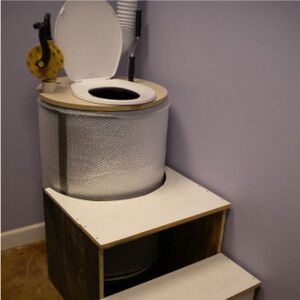
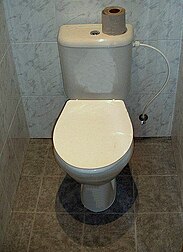
Composting toilets use biological processes to deal with the disposal and processing of human excrement into humanure. It is a system for removing feces away from humans and living areas to safely store and treat it, so that it can be reused safely for local agriculture. It comprises of a toilet, which is usually (but not always) a dry toilet or urine diversion dry toilet together with (almost always) some kind of storage system beneath, often called a latrine. This is in contrast to a pit latrine, where there is no barrier to the surrounding environment and material leaches out. This is a very important document that attempts to define clearly common terms used in the sector.
It is a very common WASH system aiming to give better health to communities than they have with open defecation and with less of the problems sometimes associated with a single pit latrine, which may leak exposing groundwater and drinking water to harmful microbes which cause illness.
Appropriate technology toilet systems can be high risk activities, see below regarding strategies to minimise risk of infection.
What is ecosan?[edit | edit source]

Ecological sanitation, or EcoSan, is the term used in WASH circles to describe sanitation systems which are dispersed (rather than being based on sewers and large municipal wastewater treatment works) and which aim to encourage people to view their own waste as a potential resource rather than as a problem.[1] This has wide applicability in countries that have complex sewerage systems as the "flush and forget" mentality is found almost everywhere.
Ecosan and composting toilets are terms that are often used interchangably and can be poorly defined. It is probably best to consider composting toilets as part of Ecological Sanitation, which can and should contain a range of other processes.
How are they supposed to work?[edit | edit source]
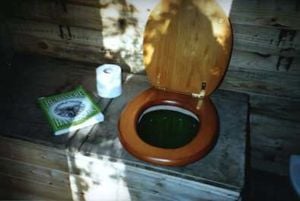
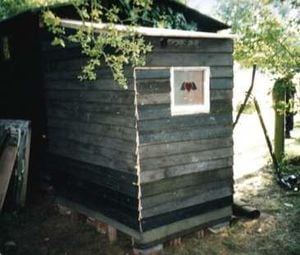
Human feces is a major pathway for micobial pathogens which cause diarrhea and other diseases which are a major cause of death, particularly of infants. The pathogens are able to survive in the feces when it is kept near body temperature, but even in circumstances where the feces is dried out completely, they may still pose a danger.
The composting process aims to encourage a situation whereby the pathogens are destroyed by competition from other 'healthy' soil micobes. This environment is created by adding carbon-rich material, reducing moisture levels and increasing oxygen by aeration.
A composting toilet is therefore a low technology method to encourage the best possible conditions to destroy the pathogens and usually involves adding available carbon-rich materials after defecation - usually ash or sawdust. There are often modifications to standard pit latrines to make them smaller, more watertight and better aerated (see below). This means that a composting toilet is usually emptied more regularly than a pit latrine might have been.
In many, but not all, systems the urine is separated from the feces as the urine is much less likely to be a source of infection and can be used more easily as a direct form of fertiliser. The composting process is usually considered to be more efficient when the feces is drier and the risk of leakage is reduced.
Toilets and latrines may also be used for temporary storage and feces removed for local secondary treatment.
Advantages[edit | edit source]
Toilet systems that dispose (processed or raw) human feces directly into the soil (ie pit latrines and flush toilets hooked upto a septic tank connected to a drain field) can contaminate waterlogged and high water table areas. This puts people at risk of catching cholera, dysentery, diarrhoea, jaundice, typhoid, polio and intestinal worms.
In waterlogged areas where there was previously no satisfactory sanitation system operating, the benefits that compost toilets provide are clear. They can prevent ground and surface water contamination and protect people's health in areas where open defecation on the ground or directly into water bodies has been the norm. The production of safe compost and effective use of the urine and wash water are also a significant benefit.
Composting toilets also protect surface and ground water from sewage pollution. Unlike flush toilets, composting toilets do not produce raw/untreated sewage should not smell. They save huge quantities of water.
The use of compost toilets means that cities and peri-urban areas do not need to extend capital intensive sewerage networks and sewage treatment plants. In addition, at least in theory, the lack of septic tanks should mean that emptying is a safer process. The recurring cost of maintaining additional infrastructure is also avoided. Both these factors represent a huge saving. Also, in areas where toilets would be flushed with municipal water there is an enormous saving in water requirements.
Cross contamination between water mains and sewers is (or should be) eradicated where compost toilets are well established as the standard sanitation technology. Soils are steadily improved by the regular addition of good quality compost.
The technology also lends itself extremely well to areas with hard rocky soils where excavation of pits is difficult, expensive or inappropriate. Again the compost is valuable and can help to provide a better chance of establishing plant cover on thin and fragile soils.
Additional advantages finally are that composting toilets can be and do not produce flies or smell if properly constructed. It also does not provide a breeding ground for mosquitoes. Septic tanks and pit latrines often have poorly fitting covers or the covers are not carefully replaced after emptying. These places then become prime breeding sites for mosquitoes which should, in theory, not exist in a composting toilet
Disadvantages[edit | edit source]
The main problem with a composting toilet is the odors and pathogens associated with it. In order to keep the odor under control, it is important to apply a covering of sawdust or other high-carbon material whenever the waterless toilet is used. This will help reduce the odor and also keep the waterless toilet and compost pile hygienic. Another method that should be used in conjunction with the high-carbon material is ventilation. This can be as simple as a gap between the wall and the roof or more complex like an electrical ventilation fan.
One major disadvantage is that compost still needs to be moved manually by the user to the agricultural field for deposit, which represents a major potential source of infection.
Efficient composting and sanitisation of feces requires consistent temperatures of over 30°C and ideally over 50°C for an extended period of time. The materials in a composting toilet may never reach that temperature or there may be limited consistency within the material so that there may be some that is not properly sanitised even where the majority is. This can be a potential problem as surviving microbes can reinoculate the remaining material.
The most efficient form of sanitation is in aerobic conditions, but in practice conditions in a given composting toilet system may be a mix of anaerobic and aerobic zones - or even largely anaerobic. This has important implications as to the effectiveness of the process as most microbial pathogens are anaerobic and are destroyed in aerobic conditions. Anaerobic digester systems have been shown to be effective at treating feces and outdoor co-composting of sludge is known to be effective, so a composting toilet may actually represent the worst of all options.
Hill and Baldwin[2] write, convincingly:
The limited body of literature on [composting toilets], especially field versus laboratory studies, generally does not prove them reliable for decomposition or sanitation of fecal matter. Adequate temperatures are seldom, if ever, attained eliminating this reliable mechanism of pathogen destruction. Storage alone is unlikely to be a reliable pathogen destruction mechanism.
In addition, most composting systems only have storage for material for 6-12 months. Poor management or unforeseen circumstances may mean that the toilets need to be emptied more regularly, which may have important consequences on the overall pathogen risk to users.
Are composting toilets safe?[edit | edit source]
Stenström et al[3] tried to assess the risk of microbial exposure from a range of WASH sanitation systems. They concluded that there were risks associated with both the operation and emptying of the facilities. If the toilet was kept clean, forms of dry toilet offered medium to low risk of infection for users and cleaners/workers. However, manually handling the material generated from these systems can be high risk.
Composting toilets are designed to destroy pathogens to produce a safe compost. However, studies have indicated that in different situations, pathogens are not necessarily destroyed. The general feces advice is that composts should not be handled for at least a year, and that they should not be necessarily considered to be fully sanitised even then. Ideally all composts from toilet pits should undergo additional treatment before being added to agricultural land.
For a fuller discussion of the academic literature on this subject, please see Infection risk from Ecosan.
In countries where the prevalence of infectious disease is very low and where there are extremely good healthcare is available, these risks may exist but the effects on individuals may be far lower. Good practice suggests, however, carefully considering the risks and pathways for infection wherever the technology is used.
Possible health risks and aesthetic issues[edit | edit source]
Human faeces can be hazardous to come in contact with when improperly or incompletely composted, because it can contain bacteria and other pathogens associated with human disease. For this reason, human waste should not be used as fertilizer without ensuring that it is composted thoroughly. The Centre for Alternative Technology (CAT) in Wales recommends that humanure should be allowed to break down for at least one year in a cool temperate climate such as that experienced in the UK, where true thermophilic decomposition cannot be guaranteed. They also advise that humanure should not be used as a fertiliser on crops that are directly handled and eaten, such as vegetables or salad leaves, but instead applied as a mulch around bush or tree fruits. Joseph Jenkins, author of The Humanure Handbook and proponent of humanure composting, recommends using composted humanure on any and all agricultural products.
Many in the 'developed world' find the idea of a composting toilet to be unappealing, perhaps due to the health and hygiene issues raised above. However, as long as basic safety rules and common sense are used, the real risks associated with a composting toilet system should be no more significant than any other situation where there may be some level of fecal contamination (eg, using a WC style toilet, changing babies nappies, taking a bath, etc). Educating people about the safe use of composting toilets is an important part of their gaining acceptance in the use of developed world. It may also be worth noting that water based toilets were originally viewed with the same type of suspicions when they replaced the chamber pot.
Many health departments will not approve composting toilets as an alternative to septic fields. A septic field may still be required for treatment of grey water even if a composting toilet is approved. Before making a significant investment, check with your local health department.
Properly designed and sized in relation to use, composting toilets neither need power for processing nor use water and will eventually reduce the solids to a final 1-2% of the added organic materials (faeces and toilet paper). True composting is a slow process and takes around 4-6 years and a variety of processes involving bacteria, fungi, worms and other micro and macro-organisms.
Ecologically, in the case of some of the more complex smaller systems it may be that the use of electricity should be weighed against the use of water within the context of a situation. In arid areas, water is probably more valuable than electricity while in wet areas, the opposite may be the case.
Creating community support[edit | edit source]
It is important to realise that any composting toilet programme also requires an education programme to ensure that the principals of use and maintenance are clearly understood and accepted by the user group.
Adequate awareness raising and training needs to be given to the users in the early stages of establishing the composting toilet. It is essential that the toilet is correctly designed and built and that there has been a very interactive and participative approach to its introduction. If these steps are taken, there is a far greater chance of the compost toilet being "owned, understood and accepted" by the community which is essential if it is to be successful.
The need for interactive training and awareness raising is to unravel and dispel the misunderstandings and confusion that often surrounds sanitation, health, hygiene, water and the environment. For example, in one project the main interest in the compost toilet was for the privacy it gave rather than because it was safer and more hygienic than open defecation. At the same time, the greatest fear of the users and neighbours was that it would smell. By knowing the fears and misconceptions, the hygiene awareness raising can be tailored to suit the needs of a specific community.
Training of the awareness team must also be done very carefully and interactively as they may have the same misconceptions as the community. It is often beneficial to build the team from amongst women and youths already active in development in the community and who are held in good regard locally. Some methods that have been effective in reaching the community are the performance of street dramas explaining the many faecal-oral routes that give rise to disease and relating them to every day events and habits. Illustrated leaflets can be distributed, games played and songs sung with children and adults, both in school and leisure time. House visits should be made to follow up the messages and discuss the dramas and leaflets. These visits can be particularly effective since people are generally more willing to express any doubts in private.
See also community-led total sanitation, which is an effort to stimulate demand for better sanitation from communities themselves.
Understanding[edit | edit source]
Composting toilets should be understood as whole systems, intended to produce safe compost which can be used as a soil amendment. So it can be helpful to consider parts of the system to include a collection vessel (toilet or urinal), a storage area (latrine, pit or storage tank) and treatment.
Sometimes composting toilets are described as small pit latrines, often with urine diversion dry toilets. Sometimes single VIP and double VIP latrines or variations are considered to be composting toilets because it is considered that useful sanitation of microbial pathogens will be occurring in the latrines.
Whilst these modifications may be helpful, particularly regarding odors and flies, the conditions in latrines are not ideal and the effect on pathogens is highly variable. All material generated by these systems should therefore be considered partially-treated at best, even if additional sawdust or ash has been added to the feces and it has been left for the recommended storage times.
The only two types of composting toilet systems that matter are therefore those which adequately destroy harmful pathogens and those that do not. Full treatment of feces within a toilet or latrine is unlikely to happen without some kind of mechanical stirring and forced aeration.
To reduce risk, material from composting toilets should never be put directly onto food crops. Storage for at least a year is highly advisable in a latrine, after which material should be removed (ideally with minimum handling) and taken for secondary treatment. The simplest secondary treatment systems are community scale co-composting or vermiculture, which have shown to be effective at sanitisation if managed properly.
During this treatment, workers may be at high risk of infection, so need to wear protective clothing. Even after treatment, feces compost should not be used on any food crop which will come into direct contact with humans - such as leaves or tubers. Ideally the compost should never be used on food crops at all.
Types[edit | edit source]
There are two basic types of compost toilet, those that complete the composting process 'in situ' and those that are emptied to a separate compost pile remote from the toilet itself. The latter arrangement is sometimes referred to colloquially as a 'bucket and chuck it' system, like a Humanure Bucket System. This means that faeces is deposited into a plastic container to which soak material such as straw, sawdust, dry grass, etc, is added in order to absorb excess liquid, cover human waste materials, exclude flies, reduce smells and balance Carbon:Nitrogen ratios. When full the bucket is removed and emptied onto a composting pile that is kept separate from other composting materials such as kitchen or garden waste.
Some composting toilets use electricity, while others do not. Some electrical systems use fans to exhaust air and increase microbial activity. Other systems require the user to rotate a composting drum or otherwise stir the composting humanure from time to time.
Some composting toilets are large with a significant space requirement in the room below the toilet. Others are not significantly larger than a traditional toilet. Those small systems generally do not claim to finish the composting on-site, but are preparing the human waste materials for secondary composting in another location (like a compost pile).
All composting toilets eventually need some end product removal. A full size composting toilet does not need to have solids removed for several decades if the active tank volume is at least three times the yearly addition. This is due to the dramatic reduction in volume over time -- after around 5 years only 1-2% of the original volume remains. It is then a mineralized soil which will not decompose any further See [3] Other smaller type systems need to remove solids several times a year.
Commercial systems[edit | edit source]
In recent years several commercial compost toilet systems have begun to compete with and replace conventional WCs in high use public facilities. There they have found a market because of their resilience and the environmental advantages of not discharging pollutants into the environment. Composting toilets reduce the volume of humanure and other organic materials on site over months or years through predominantly mesophilic composting and yield a fertilizer that is, after the legally required period of time, able to be utilized in horticultural or agricultural applications. Composting toilets are also becoming more common as an accepted alternative in homes, where the odor-free operation of a properly functioning unit appeals more to some houseowners than conventional toilets, with their consumption of large quantities of clean water.
Composting toilets have entered the mainstream plumbing realm by being tested and, if approved, labelled by the internationally acclaimed NSF - a testing facility for all types of water and sanitation products. Composting toilets have their own testing standard called Standard-41. Standard-41 can also be tested and awarded by other recognized testing laboratories such as CSA or UL.
Waterless, odorless composting toilets insure that houses can remain occupied in drought areas where water is shut off for periods of time. An example is southern Spain, where at least one composting toilet per house could provide acceptable sanitation for as long as the drought prevails and water is unavailable. Likewise it provides always-usable public toilet facilities under such circumstances. This is becoming a very important application for the technology in areas all over the world where there is only periodic availability of water.
'DIY' compost toilet systems[edit | edit source]
Far more simple and basic DIY systems can also be constructed that require very little cost or maintenance, provided that attention is paid to a number of important factors. The toilet must control odours. This is achieved by ensuring adequate ventilation (sometimes simply by leaving a small gap between the top of the wall and the roof, more sophisticated systems may incorporate some kind of low voltage extractor fan). Odours can also be controlled by either ensuring that urine and faeces are kept separate or by adding sufficient high carbon content 'soak' material (see below) to absorb excess liquid. The design of the composting toilet should allow the material to remain aerated to prevent the compost from becoming anaerobic, which can result in unpleasant odours. It must also either heat the faeces to the point that pathogens are destroyed (a thermophilic process), or else allow sufficient time (up to a year) for such pathogens to break down and disappear naturally (a mesophillic process). The upside however is that they do not use any significant amount of water and they may produce fertilizer safe for small scale agricultural use.
Another variant is the Tree bog- a type of compost toilet which never needs emptying. Nutrient hungry trees such as fast growing willows are planted around the Tree bog which take up the nutrients converting them to biomass which may then be harvested.
Dry toilet[edit | edit source]
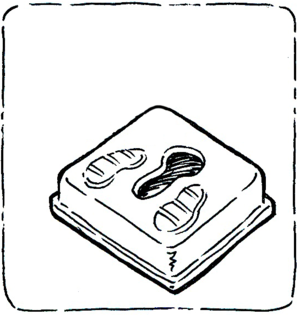
A Dry Toilet is a toilet that operates without water. The Dry Toilet may be a raised pedestal that the user can sit on, or a squat pan that the user squats over. In both cases, excreta (both urine and faeces) fall through a drop hole.
Here, a Dry Toilet refers specifically to the device that the user sits or squats over. In other literature, a Dry Toilet may refer to a variety of technologies, or combinations of technologies (especially pits).
The Dry Toilet is usually placed over a pit; if two pits are used, the pedestal or slab should be designed in such a way that it can be lifted and moved from one pit to another.
The slab or pedestal base should be well sized to the pit so that it is both safe for the user and prevents stormwater from infiltrating the pit (which may cause it to overflow).
Composting and fertilization are important steps to organic farming and gardens. In order to get the level of nitrogen needed, one may use a waterless toilet and add the product to their compost pile.
| Advantages | Disadvantages |
|---|---|
- Does not require a constant source of water.
|
- Odours are normally noticeable (even if the vault or pit used to collect excreta is equipped with a vent pipe).
|
Composting process and products[edit | edit source]
The process of converting human excrement into safe and usable compost material can take between 3 months to a few years depending on factors such as climate, temperature and the particular system being employed; and in 4-6 years will become highly mineralized soil. Some composting toilet models are concomitantly turning urine into an odor-free, pathogen-free organic liquid fertilizer. Some countries, for example Sweden, allow this liquid to be used in agriculture after a storage period of 6 months. In the full size composting toilets, urine is going through a process called nitrification, resulting in an odor free and practically bacteria free liquid fertilizer.
Urine, rather than faeces, contains the major bulk of plant nutrients worth recovering for reuse, including 90% of the nitrogen and 70% of the phosphorous. One advantage of modern composting toilets over conventional outhouses is that the latter leached most nutrients into the groundwater, instead of saving them to be reused in agriculture or spread on the land.
Case studies and how-tos available on Appropedia[edit | edit source]
Ole Ersson's sawdust toilet how-to explains how to make a simple collection system and outside composting with sawdust.
The Pedregal Permaculture Demonstration Center how-to explains the form and function of their urine diversion double pit composting toilets.
The New Dawn composting toilet how-to explains how the Costa Rican herbalism school constructed and operate their single pit composting toilet.
The Noyemberyan composting toilet page does not have much information about the system installed by Peace Corps in Armenia, but there are some good photos which show a form of single ventilated improved pit design.
Cal Poly Humboldt's CCATBox is a form of single ventilated pit latrine but with forced air pumped through it and rotating drums to ensure mixing and sanitation of the compost.
The Duchamp de Loo is another student project from Humboldt State which created a mobile toilet for use on a barge. It comprises of a urine diversion and collection system for feces which are moved elsewhere for composting.
Alternatives to consider[edit | edit source]
Related projects[edit | edit source]
Notes and references[edit | edit source]
- ↑ important document that attempts to define clearly common terms used in the sector
- ↑ Hill, G. B., & Baldwin, S. A. (2012). Vermicomposting toilets, an alternative to latrine style microbial composting toilets, prove far superior in mass reduction, pathogen destruction, compost quality, and operational cost. Waste Management.
- ↑ Stenström TA, Seidu R, Ekane N, and Zurbrügg C. Microbial Exposure and Health Assessments in Sanitation Technologies and Systems (2011). EcoSanRes
Further reading[edit | edit source]
- Fertile Waste: Managing your domestic sewage, Peter Harper, 1994, Centre for Alternative Technology (CAT), Machynlleth, Powys, SY20 9AZ, United Kingdom. Tel: +44 (0)1654 702400 Fax: +44 (0) 1654 703605. ISBN 1 89804 902 5 GBP£4.50
- Lifting the Lid: Ecological approach to toilet systems, Peter Harper with Louise Halestrap, CAT (address as above) ISBN 1 89804 979 3 GBP£10
- Low-cost Sanitation; A survey of practical experience, J. Pickford, 1995, IT Publications, 103/105 Southampton Row, London, WC1 4HH, United Kingdom. ISBN 1 85339 233 2
- Environmental Sanitation Revised and Enlarged Edition, P. Calvert et al 2004 SIDA. Sweden.
- Ecological Sanitation in India and Sri Lanka, Paul Calvert, Please visit http://www.ecosanres.org/ for more information.
- Ecological Solutions to Flush Toilet Failures ISBN 0-9547873-0-7 at http://www.eco-solutions.org/books.html
- Toilets that make Compost - low-cost sanitary toilets that produce valuable compost for an African Context by Peter Morgan 2007 SIDA Sweden
See also[edit | edit source]
- Category:Composting toilets
- Appropriate technology#Water and sanitation
- Biogas: anaerobic digestion of manure and waste plant parts generates biogas
- Wastewater
- Composting human feces
- Greywater
- Constructed wetlands
- Integrated compost heater toilet
- Humanure for soil building project
- Integrated compost heater toilet
External links[edit | edit source]
- Wikipedia:Composting toilet
- Wikipedia:Latrine
- Wikipedia:BiPu (emergency latrine)
- Wikia:Permaculture:Composting toilets
- Composting toilet FAQ, Composting Toilet World website, sponsored by Envirolet (Sancor).
- City Farmer on composting toilets
- RILES: A U.S. organization working on issues related to sustainable sanitation
- A photo essay on the construction of a 'DIY' compost toilet
- podcast by Paul Wheaton and Jocelyn Campbell on food matters discusses composting toilets between minutes 34-51
- Toilet alternatives forumsat Permies.com
- RILES: A U.S. organization working on issues related to sustainable sanitation
- City Farmer Page
- www.poohsolutions.com
- Compost toilet building workshop in Essex, England
- A photo essay on the construction of a 'DIY' compost toilet
- 'The Humanure Handbook'
- Composting Toilet World
- BioLet Composting Toilets
- Sun-Mar Composting Toilets
- Envirolet Composting Toilets
- UKLoos Composting Toilets
- Nature's Head Composting Toilets